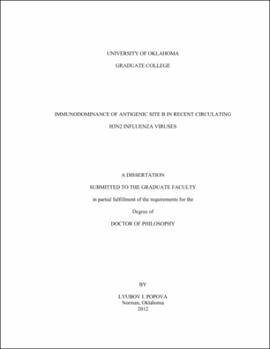| dc.contributor.advisor | West, Ann H.||Air, Gillian M. | |
| dc.creator | Popova, Lyubov I. | |
| dc.date.accessioned | 2019-04-27T21:28:44Z | |
| dc.date.available | 2019-04-27T21:28:44Z | |
| dc.date.issued | 2012 | |
| dc.identifier | 99225161402042 | |
| dc.identifier.uri | https://hdl.handle.net/11244/318784 | |
| dc.description.abstract | Type A influenza viruses cause seasonal epidemics and global pandemics driven by antigenic drift in the viral surface glycoproproteins, hemagglutinin (HA) and neuraminidase (NA). Each year in the United States more than 200,000 people are hospitalized and 20,000-36,000 people die from flu-related complications (CDC, 2011). Subtype H3 HA has accumulated 20.4% amino acid sequence changes in HA1 in the 42 years since it appeared in humans in 1968. Five antigenic sites, A-E, were mapped on the surface of 1968 and 1971 HAs by escape mutant analysis and competition assays using monoclonal antibodies (mAbs), but there are no detailed mapping studies of recent H3 HAs. The presence of five antigenic sites on HA would appear to mean that host immune response might be limited to only the most immunodominant antigenic site on HA. The goal of our research is to determine if there is immunodominance of particular antigenic sites and whether this immunodominance changes from year to year due to accumulation of mutations in antigenic sites during antigenic drift. | |
| dc.description.abstract | To test the immunogenicity of antigenic sites in modern H3N2 viruses we analyzed the epitopes of two human monoclonal antibodies, E05 and 1_C02, specific to HA1 of vaccine strain A/Wisconsin/67/05 (H3N2) and Wisconsin-like influenza A/Oklahoma/309/06. To partially map the epitopes of E05 and 1_C02 we used mutants of HA of Wisconsin-like influenza A/Oklahoma/309/06 (H3N2) in antigenic site A (NNES121-124ITEG, N126T, N133D, TSSS135-138GSNA, K140I, RSNNS142-146GPGSG), and antigenic site B (HL156-157KS, KFK158-160GST, NDQI189-192QEQT, A196V). | |
| dc.description.abstract | To estimate the immunodominance of antigenic sites in recent H3N2 influenza virus HA we studied the binding of antibodies in human plasma after seasonal vaccination in 2006-2007 (H3N2 component A/Wisconsin/67/05) and after vaccination in 2008-2009 (H3N2 component A/Uruguay/716/07) to wild type and mutant recombinant HA proteins. We used the same panel of mutant HAs to determine the specificity of polyclonal antibodies in postvaccination human plasmas. Our results suggest that antigenic site B is immunodominant over antigenic site A in recent H3N2 viruses. | |
| dc.description.abstract | To confirm the immunodominance of antigenic site B in recent influenza viruses we isolated escape mutant viruses of A/Perth/16/08 selected with post-vaccination human plasmas in season 2010-2011 (H3N2 component A/Perth/16/09 from two individuals. Both contained two mutations (H156Q and G186V) in antigenic site B of HA and there was no mutation in antigenic site A of HA. Our results suggest that antigenic site B of A/Perth/16/09 is immunodominant in both subjects. Together with serum reactivities against mutant recombinant HAs, these results confirm that antigenic site B has been immunodominant over site A in H3N2 viruses at least since 2005 even though there have been changes in both sites A and B between A/Wisconsin/67/05 and A/Uruguay/716/07 and between A/Uruguay/716/07 and A/Perth/16/09. | |
| dc.description.abstract | The understanding of immunodominance of antigenic sites of HA may allow to predict the antigenic drift and design the vaccine ahead to influenza epidemics. | |
| dc.format.extent | 148 pages | |
| dc.format.medium | application.pdf | |
| dc.language | en_US | |
| dc.relation.requires | Adobe Acrobat Reader | |
| dc.subject | Influenza | |
| dc.subject | Antigens | |
| dc.subject | Immunogenetics | |
| dc.subject | Immune response | |
| dc.title | IMMUNODOMINANCE OF ANTIGENIC SITE B IN RECENT CIRCULATING H3N2 INFLUENZA VIRUSES | |
| dc.type | text | |
| dc.type | document | |
| dc.thesis.degree | Ph.D. | |
| ou.group | College of Arts and Sciences::Department of Chemistry and Biochemistry | |
